Honda Civic
Rear Brake Pads Replacement Guide
How to change the rear disc brake pads on
a tenth generation 2016, 2017, 2018 & 2019 Honda Civic sedan.
By Paul B. Michaels Author & Photographer Auto Mechanic Since 1989 |
||
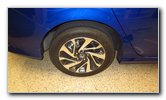 2016 Civic Rear Wheel |
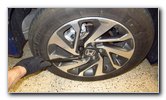 Slightly Loosen Lug Nuts |
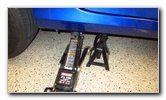 Raise Rear of Vehicle |
| This automotive
maintenance tutorial was specifically written to assist owners of the tenth
generation 2016, 2017, 2018 and 2019 Honda Civic sedan in changing the rear
disc brake pads and lubricating the caliper slider pins. Owners of other Honda or Acura vehicles such as the Accord, Insight, Clarity, Fit, HR-V, CR-V, Pilot, Passport, Odyssey, Ridgeline, ILX, MDX, RDX, NSX, RLX and TLX may also find these DIY instructions to be helpful. A few compatible replacement sets of new rear brake pads with their part numbers include the following: Power Stop Z23-1878, Hawk Performance HB900B.572, KFE KFE1878-104 and Callahan CPK01173. Please use the Amazon Part Finder website to verify the correct replacement part numbers for your Civic. The compatible brake pads may vary depending on the model year, trim level (LX, EX, EX-T, EX-L, Touring, Type R) and body style (coupe or sedan). The tools and other items needed to complete this procedure include a lug nut wrench, a floor jack, two jack stands, a 7mm hex head socket with a 3/8" drive ratchet or a 7mm Allen key wrench, a Lisle 28600 disc brake piston tool and a tube of brake caliper grease.
The first few steps are to park the car on a level surface, shift the transmission into "Park" and turn off the ignition. Make sure the emergency / parking brake is not engaged. If the EPB (electronic parking brake) hasn't been released, you will not be able to pull the rear caliper off the pads and out of the bracket. Just to be clear, make sure the EPB is OFF.
You may be able to visit a Honda / Acura dealership and have a technician use the HDS to place the EPB in maintenance mode for you. I have read that the 2016+ 10th generation Honda Civic service manual does mention that the rear brake pad can be done without using the HDS. It states "Without using the HDS: Rotate the caliper piston (A) clockwise into the cylinder by using the commercially available disc parking tool (B). The other method I've seen done is to use a 12V power source to electronically retract or apply the EPB at the connector. If you don't place the EPB in service mode, there is a chance that rotating the screw-in type rear caliper piston back manually may trigger a warning on the gauge cluster that reads "Electric Parking Brake Problem" with a yellow warning light that says "BRAKE SYSTEM". Place wheel chocks on both sides of the front tires to prevent the vehicle from moving. Slightly loosen the five lug nuts on the rear wheel by turning them 1/4 to 1/2 turn in the counterclockwise direction with a tire iron. Carefully raise the front of the car with the floor jack and securely support it with at least two jack stands. Please do not solely rely on the floor jack to support the vehicle! I prefer to only work on one side of the car at a time to keep three tires on the ground for extra safety. |
||
|
|
||
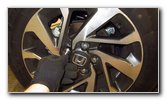 Spin Off Five Lug Nuts |
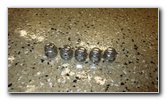 5 Lug Nuts Removed |
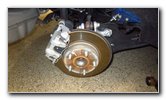 Caliper, Bracket, Rotor |
|
Spin off the five lug nuts and set them aside in
a safe place. Carefully remove the rear wheel and set it aside. Some people like to place the wheel and tire below the frame rail of the car just in case both the floor jack and the jack stands fail. Once the rear wheel is out of the way, you'll be able to see the caliper, bracket, rotor and suspension. |
||
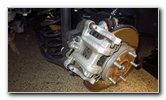 Rear Brake Caliper |
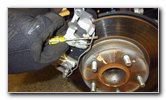 Pry Off Metal Spring Clip |
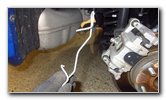 Caliper Support Spring |
|
Use a flat head screwdriver to carefully pry off
the metal caliper support spring.
Be careful when you remove the metal spring clip since it might fly off and hit you in the face or eyes. Set the spring clip aside in a safe place. |
||
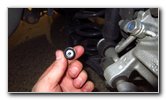 Pull Of Plastic Cap |
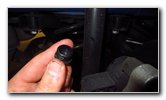 Plastic Caliper Bolt Cover |
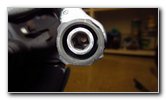 Hex Head / Allen Bolts |
|
Pull off the two black plastic caps on the back
side of the caliper that cover the two bolts. Set the caps aside in a safe place. |
||
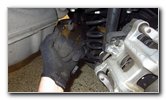 Loosen Lower Bolt |
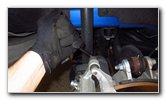 Loosen Upper Caliper Bolt |
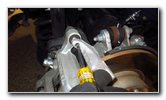 Push Out Caliper Bolt / Pin |
|
Loosen the lower caliper bolt by turning it in
the clockwise direction (as seen from the outside of the car) with the 7mm
hex head socket or a 7mm Allen key wrench. Then loosen the upper caliper bolt by also turning it in the clockwise direction (when viewed from the outside of the car). |
||
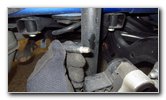 Top Bolt / Pin Removed |
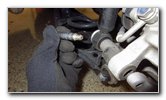 Remove Lower Bolt / Pin |
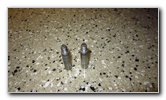 Caliper Bolts / Slider Pins |
|
Spin out the two caliper bolts which also act as
the caliper slider pins. You may need to use a small flat head screwdriver to push the pins out of the caliper. Set the two combination caliper bolts / pins aside in a safe place. |
||
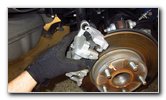 Lift Caliper Off Pads |
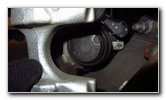 Screw-In Type Piston |
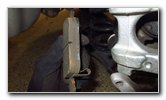 Wear Bar Bottom Inner Pad |
|
Carefully lift the caliper out of the bracket
and off the old pads.
The 10th generation Civic is equipped with "screw-in" type rear caliper pistons that need to be turned back in the clockwise direction to retract them. (The front caliper pistons can be simply pushed or "compressed" back in with an F clamp.) Do not try to compress the rear pistons with an F clamp! Pull the old inner and outer brake pads out of the bracket. Make a mental note of where the wear indicator bar or "squeal bar" is situated on the old pads. On this 2016 Civic sedan, the wear indicator bar was situated at the bottom of the inner brake pad. |
||
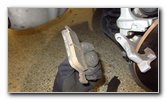 Remove Outer Pad |
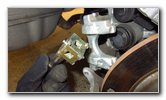 Caliper Piston Tool |
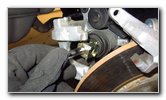 Test Fit Piston Tool |
| Discard the old
brake pads. Test the various sides of the Lisle 28600 disc brake piston tool to see which side has the best fit or "grip" on the piston. Attach the piston tool to a short extension bar and a 3/8" drive ratchet.
Slowly turn the rear piston back in the clockwise direction to retract it into the caliper. If you have trouble rotating the piston, double check that the EPB (electronic parking brake) has been released.
If you still can't turn back the piston, you may need to use a HDS (Honda Diagnostic System) computer or an aftermarket OBDII scanner (or "OBD2 scan tool") to retract the EPB and place it in "service" / "maintenance" mode. Do not force the rear piston if it won't turn to prevent from damaging the electric parking brake or the caliper!
Here is a manual method of retracting the EPB
as detailed on the CivicX Forum.
Make sure the EPB (electronic parking brake) is OFF, the ignition is OFF, the car is in PARK and there are wheel chocks on both sides of the front tires! 1. Remove the electronic parking brake
actuator from the rear caliper. Another method I've seen done is to use a 12V power source such as an old car battery or a jump starter pack to electronically retract or apply the EPB motor. It requires disconnecting the electrical connector for the EPB and applying the bare wire leads to the two electrical contact pins. As always, please proceed with caution and at your own risk. If you get any "Electronic Park Brake Problem" warning lights or messages, use an OBD2 Scanner to check the codes and re-check your work. Another mechanic recommends trying the following procedure if you see a "Electronic Park Brake Problem" message or warning light. 1. Turn the ignition to OFF. This sounds like a procedure for the computer to reset or re-learn the EPB motor position. You can also remove the brake reservoir cap at the right rear corner of the engine bay to allow the brake fluid to more easily travel back through the lines. |
||
|
|
||
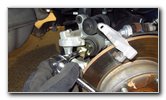 Turn Back Caliper Piston |
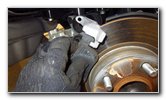 Install Outer Brake Pad |
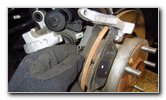 Wear Bar - Bottom Inner |
|
Continue turning back the piston until it is just about flush with the rubber dust boot that surrounds it. If your Civic has been exhibiting shuddering or vibrations in the rear end when you step on the brake pedal, you may need to replace the OEM rotors with new rotors. To replace the rotors, remove the Phillips head set screw on the outer face of the rotor near the lug studs. Then remove the two bracket bolts and the bracket. Slide the old rotor off and push the new in place. Replace the set screw, the bracket and the two bracket bolts. The service manual specification for the rear bracket bolts is 55 lb-ft (or 75 N-m) of torque. Clean off the rotor, lug studs, caliper and bracket with brake parts cleaner spray. Install the two new rear brake pads into the bracket. The wear indicator bar should be situated at the bottom of the inner brake pad. |
||
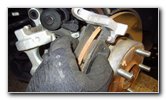 Push Pads Against Rotor |
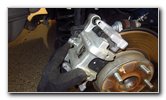 Lower Caliper Over Pads |
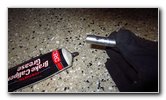 Lubricate Slider Pins |
| Push the two pads
together until they are flush against the rotor. Carefully lower the caliper over the new brake pads and into bracket. Try to avoid pulling on, stressing, kinking or bending the rubber brake fluid hose. Line up the bolt holes in the caliper with their corresponding bolts holes in the bracket. In order for the caliper to operate smoothly, the two caliper slider pins need to be well lubricated. Apply a thin layer of brake caliper grease to the smooth parts of the combination bolts / pins. |
||
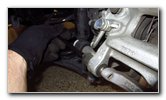 Replace Bottom Pin / Bolt |
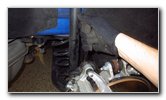 Tighten Top Bolt / Pin |
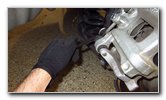 Tighten Bottom Bolt |
| Spin in the two
caliper bolts in the counterclockwise direction (as seen from the outside of
the car). Tighten the two caliper bolts to just past hand tight. If you have a torque wrench, the service manual specification for the rear caliper bolts is 17 lb-ft (or 23 N-m) of torque. Double check that the two caliper bolts are tight before moving on to the next steps. |
||
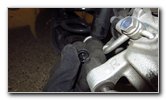 Push In Black Plastic Cap |
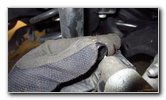 Replace Top Plastic Cap |
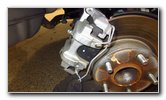 Re-Attach Spring Clip |
| Replace the two
round black plastic caps that cover the caliper bolts. Re-attach the caliper support spring. |
||
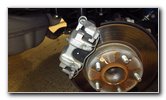 Caliper Support Spring |
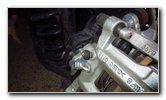 Rubber Valve Cap |
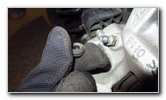 Brake Fluid Bleeder Valve |
|
If your brake pedal has been feeling soft or spongy, there may be some air bubbles or moisture in the brake fluid. It would be best to bleed your brakes at this time to flush out the old fluid with fresh new genuine Honda DOT 3 brake fluid. (The owner's manual specifies that you may use DOT 4 brake fluid or another brand of DOT 3 brake fluid but do NOT use DOT 5 since DOT 5 could damage the braking system.) I personally use and highly recommend the Allstar Bleeder Bottle for changing brake fluid. It has a one way check valve and a strong magnet to hold it to the rotor which makes bleeding the braking system and easy one person job. Check out my Acura MDX Brake Fluid Bleeding Guide for more information on the procedure. The brake fluid bleeder valve is located on the back side of the caliper just below the top caliper bolt. It is covered by a black rubber cap. To open and close the bleeder valve, you'll need a 10mm wrench. Double check that the caliper bolts, bracket bolts and bleeder valve are all tight before moving on to the next steps. |
||
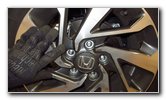 Replace Rear Wheel |
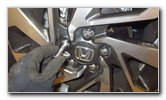 Spin On 5 Lug Nuts |
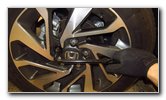 Slightly Tighten Lug Nuts |
| Push the rear wheel
back into place over the lug studs. Spin on the five lug nuts a few turns by hand in the clockwise direction to help prevent them from becoming cross threaded. Slightly tighten the lug nuts in the clockwise direction in a criss-cross or star pattern with the tire iron. |
||
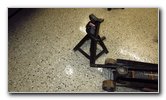 Lower Car From Stands |
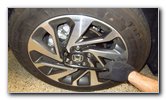 Torque Lug Nuts |
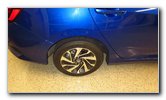 Rear Brake Pads Done |
|
Carefully lower the car from the jack stands by using the floor jack. Continue progressively tightening the lug nuts in the clockwise direction in a criss-cross or star pattern with the tire iron to about 1/8th to 1/4th of a turn past hand tight. It would be best to use a torque wrench to properly tighten the lug nuts to the owner's manual specification of 80 lb-ft of torque. Check the brake fluid level in the reservoir bottle and pour in some new DOT3 fluid until the level reaches the "MAX" (maximum) line. Be sure to record the brake pad change in your vehicle's service records. Over the next few days, keep an eye on your parking space, garage or driveway for drops of fresh brake fluid which might indicate a leak from the bleeder valve or the reservoir. It would also be a good idea to double check that the lug nuts are still tight after your next trip. Please
check out all of my
2016-2019 Honda Civic DIY Repair & Maintenance Guides. |
||
| If you found this guide to be helpful,
please consider making a small donation by clicking on the PayPal.com
"Donate" button located to the right of this paragraph. Thank you!
(Note: I am not a registered charity. Donations are not tax deductible.) |

